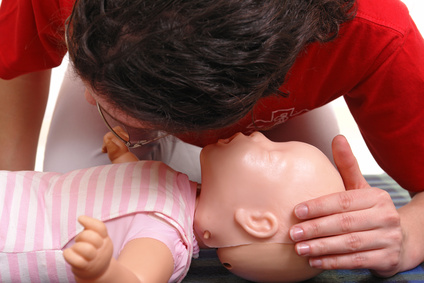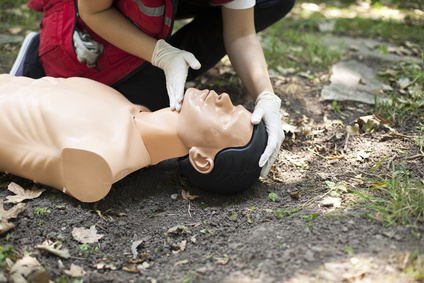Chest Compressions Circulate the blood within the patient. It's important to place your hands correctly upon the patient’s chest when performing compressions.
To do so, find the point where the patient’s ribs meet (just below both halves) and interlock your fingers with both hands. Make sure you’re kneeling beside the patient’s shoulders (Do Not Lean on Patient). Once in position, lock your elbows and use your body’s weight to compress 2 inches upon the patient’s chest. Make sure to let the patient’s chest rise after each compression. Compressions on an infant are pressed just below the nipples.
Infant CPR - 2 Rescuers: One Rescuer should use two hands holding the infant facing up while positioning the fingers in the middle of the infant’s chest as the other rescuer uses a one-way valve—placing it over the infant’s mouth and nose. One rescuer will perform compressions while the other uses the rescue valve. You can also apply a ratio of 15:2 compressions to breathing.
Chest Compression Tempo: the correct tempo that should be performed matches the song “Staying Alive.” Make sure to push hard and fast to that song’s tempo.
Chest Compression Fraction: is the total percentage of resuscitation time when performed by the rescuer(s) during cardiac arrest. Whether intended or unintended interruptions (such as real-world delays) occur Chest Compression Fraction aims to minimize pauses in chest compressions. Chest Compression Fraction Goal: target of at least 60%
Remember, CPR should be administered until help arrives. 100-120 compressions should be performed per minute.
Chest compressions should be performed on patients who are obese.
Chest compressions should be performed on pregnant women and a modification if the pregnant woman’s fundus height is at or above the level of the umbilicus. If the woman’s fundus height is at or above the umbilicus, then High-quality CPR with manual left uterine displacement will be beneficial for relieving aortocaval compression during, the chest compression task. To perform manual left uterine displacement: push the uterus to the patient’s left side with 1 hand while still providing CPR.
A is for Airway. Clear the Airway
Check for any obstructions, such as: tongue, foreign objects, vomit, swelling, or food blocking the patient’s throat or windpipe (finger-swipe, if necessary).
Make sure the patient is on a solid/firm surface (on his/her backside). Next, kneel beside the patient’s neck/shoulders. Open the patient’s Airway by tilting the head back with the palm of 1 hand as the other hand gently lifts the chin. For no longer than 10 seconds, check for life: listen for any sounds, put your cheek beside the patient’s mouth to feel for breathing, and look for any motions. Tasks can be performed simultaneously.
Chest Compressions should be performed on patients who are obese or pregnant.
B is for Breathing. Mouth-to-Mouth
Rescue Breathing is widely known to be performed mouth-to-mouth—it can also be performed mouth-to-nose, mouth-to-mask, and mouth-to-stoma, but in rare cases.
Breathing tasks: While still performing the Airway technique pinch the patient’s nose shut. With a complete seal over the patient’s mouth, with your mouth, breathe into the patient until you see the chest inflate. If the chest does not inflate repeat the Airway technique. When performing the breathing technique make sure to give 2 breaths for 1 second each.
Once the breathing technique is applied you will continue the C-A-B’s.
CPR for Infants (Age Less Than 1 Year, Excluding Newborns)
- Witnessed Collapse: call 911 or have someone call
- Un-Witnessed Collapse: perform CPR (for 2 minutes), call 911 or have someone call
- Chest compressions - 100-120/min
- Perform CPR - Circulate, Airway, Breathing (C-A-B’s)
- Compressions at about 1½ inches (4 cm) - 1/3 AP diameter of chest
- 30:2 compressions over breaths (seal infant’s mouth and nose) - 2 Rescuers 15:2
- 2 Rescuers: 2 thumbs compression
- Use AED as soon as it's available
- Check the environment – making sure it’s safe for rescuers and victims
- Check responsiveness
- No breathing or only gasping – ie: no normal breathing
- Within 10 seconds – no definite pulse
- (You can check for a pulse and breathing simultaneously in less than 10 seconds)
- Witnessed collapse 1. Leave the victim, if you’re alone without a mobile phone, and activate the emergency response system while retrieving an AED before performing CPR
- Unwitnessed collapse 1. Give 2 minutes of CPR 2. Activate the emergency response system, get an AED and return to the victim 3. Resume CPR; use the AED as soon as it is available
- 1 rescuer 30:2
- 2 or more rescuers 15:2
- Chest compressions – 100-120/min
- Give 1 breath every 6 seconds (10 breaths/min)
- 100-120/min
- At least 1/3 AP diameter of chest
- About 1½ inches (4 cm)
- 1 rescuer Just below the nipple line – 2 fingers in center of chest
- 2 or more rescuers 2 thumb–encircling hands in the center of the chest, just below the nipple line Just below the nipple line – encircling hands (2 thumbs) in center of chest
- Make sure not to lean on the chest of the victim – Allow a full recoil after each chest compression
- Compression interruptions – limit to less than 10 seconds
- Witnessed Collapse: call 911 or have someone call
- Un-Witnessed Collapse: perform CPR (for 2 minutes), call 911 or have someone call
- Chest compressions - 100-120/min
- Perform CPR - Circulate, Airway, Breathing (C-A-B’s)
- Compressions at about 2 inches (5 cm) - 1/3 AP diameter of chest
- 30:2 compressions over breaths - 2 Rescuers 15:2
- 2 Rescuers: Perform tasks simultaneously
- Use AED as soon as it's available
- Check the environment – making sure it’s safe for rescuers and victims
- Check responsiveness
- No breathing or only gasping – ie: no normal breathing
- Within 10 seconds – no definite pulse
- (You can check for a pulse and breathing simultaneously in less than 10 seconds)
- Witnessed collapse 1. Leave the victim, if you’re alone without a mobile phone, and activate the emergency response system while retrieving an AED before performing CPR
- Unwitnessed collapse 1. Give 2 minutes of CPR 2. Activate the emergency response system, get an AED and return to the victim 3. Resume CPR; use the AED as soon as it is available
- 1 rescuer 30:2
- 2 or more rescuers 15:2
- Chest compressions – 100-120/min
- Give 1 breath every 6 seconds (10 breaths/min)
- 100-120/min
- At least 1/3 AP diameter of chest
- About 2 inches (5 cm)
- 1 or 2 hands can be used (optional for small children)
- On the lower half of the breastbone (sternum)
- Make sure not to lean on the chest of the victim – Allow a full recoil after each chest compression
- Compression interruptions – limit to less than 10 seconds
CPR for Adults & Adolescents
- Check for life
- Before performing CPR call 911 or have someone else call
- Chest compressions - 100-120/min
- 2 Rescuers: Perform tasks simultaneously
- Perform CPR – Circulate, Airway, Breathing (C-A-B’s)
- Compressions at about 2 inches (5 cm)
- 1 or 2 rescuers - 30:2 compressions over breaths
- Use AED as soon as it's available
- Check the environment – making sure it’s safe for rescuers and victims
- Check responsiveness
- No breathing or only gasping – ie: no normal breathing
- Within 10 seconds – no definite pulse
- (You can check for a pulse and breathing simultaneously in less than 10 seconds)
- If you do not have a mobile phone – leave the victim and activate the emergency response system while retrieving an AED before performing CPR.
- Have someone activate the emergency response system. Perform CPR immediately and use the AED as it becomes available.
- 1 or 2 rescuers – 30:2
- Chest compressions – 100-120/min
- Give 1 breath every 6 seconds (10 breaths/min)
- 100-120/min
- At least 2 inches (5 cm)
- 2 hands on the breastbone (sternum) on the lower half
- Make sure not to lean on the chest of the victim – Allow a full recoil after each chest compression
- Compression interruptions – limit to less than 10 seconds
- Compress slower than 100/min or faster than 120/min
- Compress in depth less than 2 inches (5 cm) or more than 2.4 (6 cm)
- Lean on victim’s chest during compressions
- Allow interruption during compressions more than 10 seconds
- Provide excessive ventilation during breathing task, ie: excessive breathing with force or too many breaths
CPR on obese patients
Yes, perform Chest Compressions
CPR on pregnant patients
Yes, perform Chest Compressions and a modification if the pregnant woman’s fundus height (baby-bump) is at or above the level of the umbilicus. If the woman’s fundus height is at or above the umbilicus, then High-quality CPR with manual left uterine displacement will be beneficial for relieving aortocaval compression during, the chest compression task. To perform manual left uterine displacement: push the uterus to the patient’s left side with 1 hand while still providing CPR.
Oxygenation and airway management should be prioritized during resuscitation from cardiac arrest in pregnancy because pregnant patients are more prone to hypoxia.
Fetal monitoring should not be undertaken during cardiac arrest in pregnancy because of potential interference with maternal resuscitation.
Opioid poisoning CPR for healthcare providers
1. Suspected opioid poisoning
- Check for responsiveness
- Shout for nearby help
- Activate the emergency response system
- Get naloxone and an AED if available
If yes, prevent deterioration:
- Tap and shout
- Open the airway and reposition
- Consider naloxone
- Transport to the hospital
If no, does the patient have a pulse? Assess for 10 seconds.
If yes, support ventilation:
- Open the airway and reposition
- Provide rescue breathing or bad-mask device
- Give naloxone
If no, start CPR:
- Use an AED
- Consider naloxone
- Use high-quality CPR






